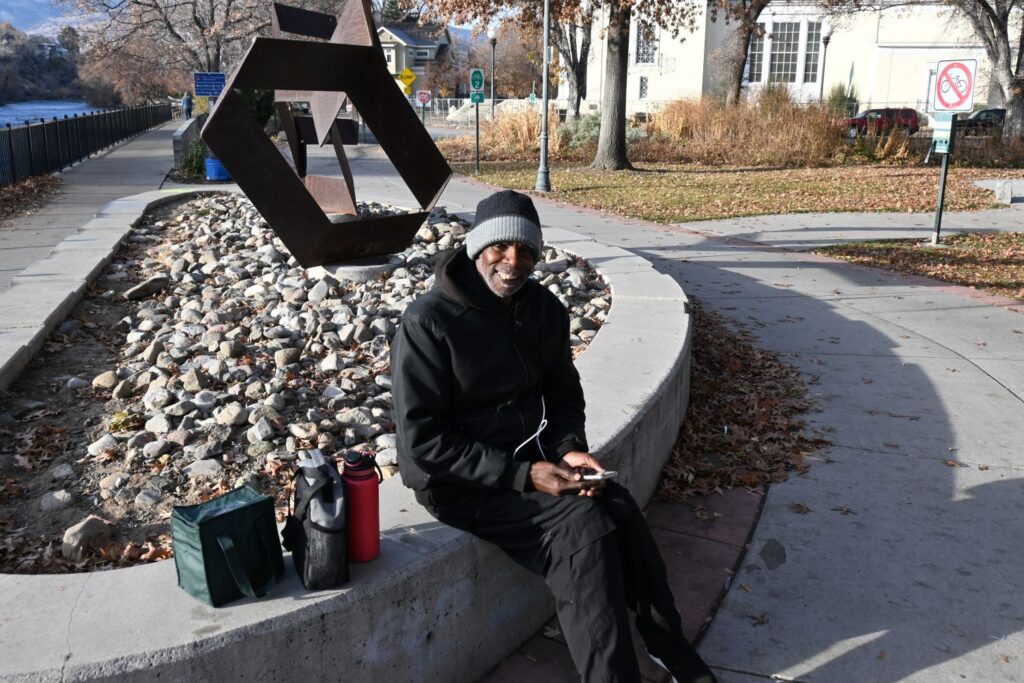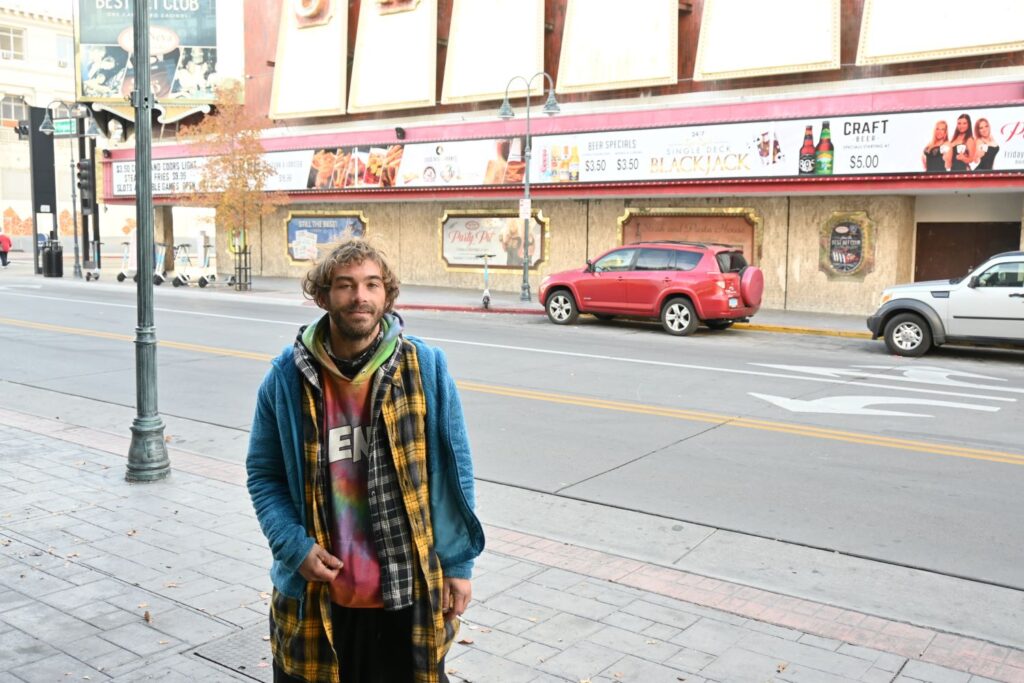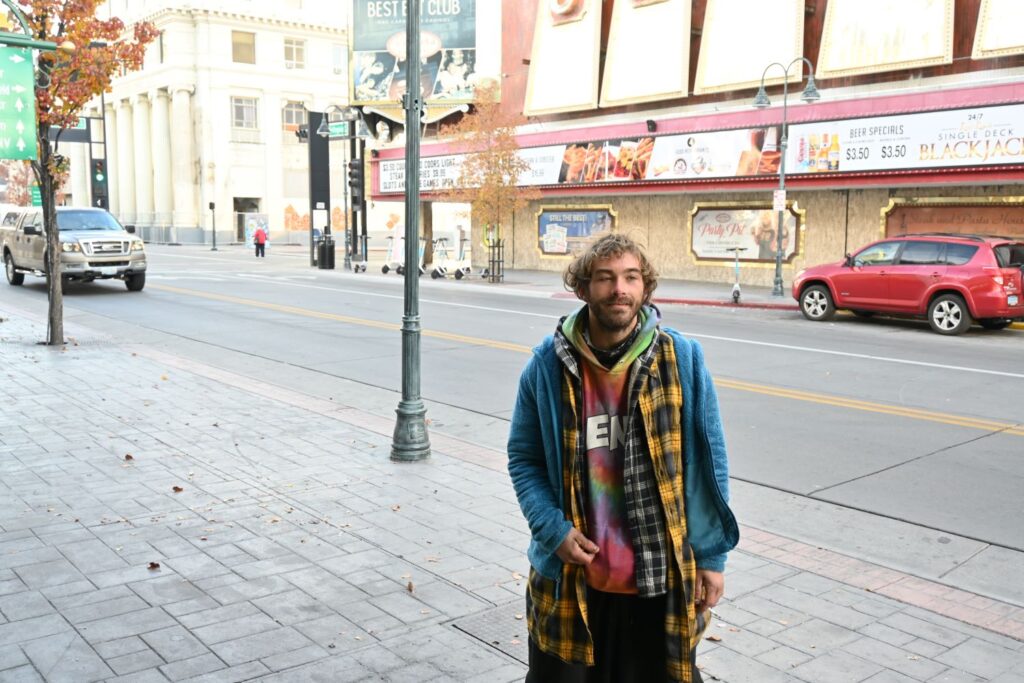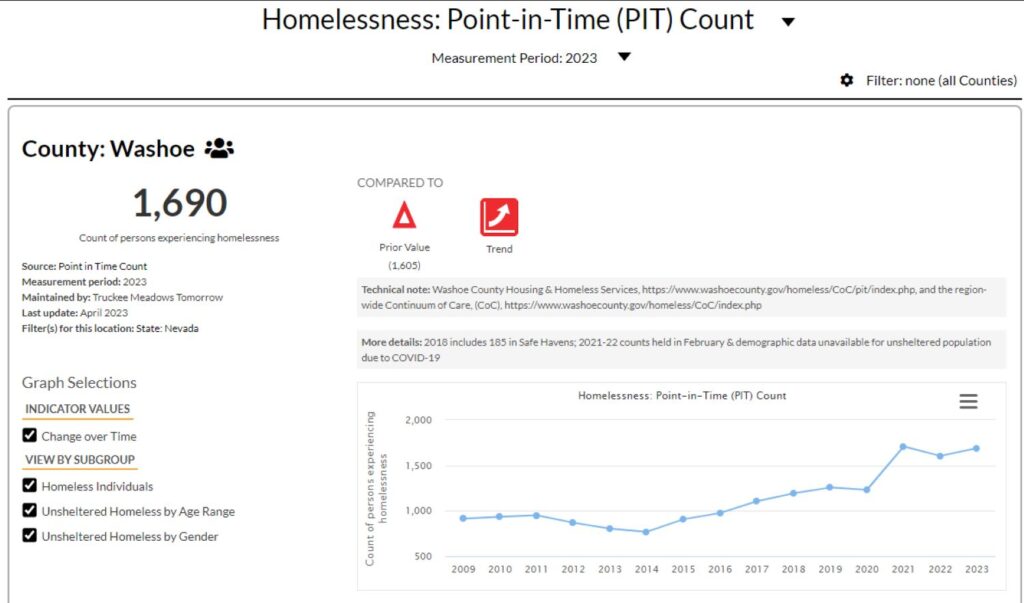In a recent article published by The Wall Street Journal, Reno received praise for its efforts in curbing homelessness. The headline describes Reno as “beating the odds” and leads off by describing how the Nevada Cares Campus, a shelter consisting of a giant tent with satellite sleeping pods, has cut the number of homeless people living on the street in over half. This should be something to celebrate and rejoice over, right? One would think, however, through random interviews of unhoused people, questions of the effectiveness of this system have arisen. First, I’ll need to provide the context for this story, as it came about by total accident.
Having moved to Reno recently in August to pursue my masters in journalism, I’m still fairly new to town. With the winter approaching, the weather was getting colder than I had expected. I was curious as to how the homeless population would handle this, as I noticed many people camping out in parks or by the Truckee River. For my final project in my multimedia course, I decided to interview some people, simply to see how they were doing with the cold and possibly learn their stories. What I didn’t expect was for this common thread to emerge about the Nevada Cares Campus.
It is important to state that for my project I did not have the time to launch a full investigation into this organization. So my intent with this project is not to make accusations or claims against anyone. I simply interviewed people at random and the three most coherent interviews I conducted are the ones I use in this project. My goal is to simply let the stories unravel organically through text, photography, and most importantly the voices of the people. The ultimate goal of this project is not to pass judgement on anyone, but rather to share the stories and wisdom of these people who so often go overlooked and unheard. So without further ado, let me introduce you to Stringz.
Stringz
I’ve often noticed a man with a guitar, especially when the weather was nicer, strumming tunes by the river. He’s always been friendly and said hello, so I asked if he’d like to interview. He happily obliged and we began just by chatting about his general well-being and current needs. Rather than share with me his actual name, he provided me with his stage name, “Stringz”. Stringz mentioned that he was cold and listed warmer clothes and a warm space to sleep as needs, so this provided a natural entry point into unpacking his experience with the cold. Upon asking Stringz if he had a plan for the dropping temperatures, I would hear of the shelter for the first time.
I learned that Stringz didn’t particularly believe in the shelter’s ability to enable his success, due to overcrowding and “terrible” scheduling. Stringz wasn’t one just to focus on problems however, he would go on to provide what he sees as a potential solution, in utilizing unoccupied buildings to house the homeless. He would also pose a few very important question, “Where is the love?”. Listen here:

As we chatted more, Stringz reiterated a need to solve the problem with homelessness. In Stringz’s opinion, the problem is trending downwards, citing Reno’s low-cost of living as a factor. He warned that if its not addressed, then the situation could get “ugly”. Next, Stringz would then share with me a bit of his story, primarily about his family and music. He would share with me a powerful message about remaining positive and keeping his faith despite his circumstances. Finally, I asked Stringz if there was anything else he’d like to let people know, and he imparted some final words of wisdom. Listen to the second part here:

I thanked Stringz for his time, and gave him some cash, which ironically, he said he would be using to purchase a new string for his guitar.
Daniel
Next, I interviewed a young man with the same name as myself, Daniel. Daniel was passing through the skate park underneath the “Believe” sign in downtown Reno. Underneath this sign unhoused people tend to congregate, and Daniel was willing to take some time to answer questions. “You’re definitely older than I am.” Daniel said, prior to beginning our interview. Myself only being twenty-six, this interview hit very close to home for me, as I kept thinking how our situations could easily be reversed, had we been dealt different hands.
Similarly to Stringz, we started off by discussing how Daniel was in that moment, and what were his greatest needs. However, Daniel described how, other than the cold, he is having different challenges than Stringz mentioned. Daniel seemed to be having issues more with getting the documentation he needed to get into housing programs, as well as a job, and other ventures that documentation requires. While trying to explore these challenges more, Daniel painted a vivid picture of his experience with the cold, as well as an issue he has with asking for help. I proceeded to ask Daniel about his plan for the winter, particularly if there was any help he could look to. He shared with me some background about his family, and how he lost that option. Daniel also described what eventually lead to him becoming homeless. Listen here:

Next, I tried asking if perhaps the city has been able to provide him with some resources. Daniel has not had good experiences going with that route either, and when I asked him for a specific example of somewhere he hasn’t had luck, he named the Cares Campus.
Daniel claimed although making several efforts, they could not “help get his show going”. I asked Daniel if he was interested in sharing anything about his story at all, but he had reservations. He described to me the terrifying experience of the other times he’s tried to tell his story. Finally, I asked Daniel if there’s anything he wanted people to know, and he provided an important message that we too often forget. Listen to part two here:

After talking to Daniel I found out that not only was he articulate, but he had his own hopes and dreams. “I was hoping to be an ER doctor married with kids by now.” he told me after the interview.
Susan
Thanks to my colleague Ray, I was introduced to Susan who is currently staying at the Cares Campus at the time of this project. I offered to meet Susan there at the shelter. We ended up meeting just outside on the street corner, as Susan informed me no outside visitors are allowed within. We walked down to a nearby bus station so we could sit and be more comfortable for the interview.
Susan was very open and candid with me off the bat and shared a lot about who she was, and her mentality while being homeless. She shared with me that she has kids who don’t know where she is, that she hopes find her one day. Susan also shared what she thinks happened to her legs that she now needs a walker, with the cold being a big factor. While on the topic of the cold, Susan began mentioning her experience at the shelter. We began to unpack this, and Susan pointed out the irony in the shelter being called the “Cares” Campus. Listen here:

Susan continued telling me about her experience at the shelter, stating that she doesn’t even have a bed yet, and the people there haven’t been kind to her in the interim. We then spoke more about her experience living on the street past winters and how she survived. Like Stringz, she cited her faith as what helps get her through, but shared another unique method. During the interview, Susan took out her teddy bear to show me, and explained how she always carries it with her for comfort.
Susan went on to share what she misses about having a home, primarily cooking, the feeling of security that comes with having a home, and being able to take a shower anytime. Finally, when asked if there was anything she’d like to share with people, Susan reflected on human interactions she sees on the streets. She condemned the amount of hate there is out there, and also advocated for more love. Listen to the second part here:

After the interview, I walked Susan as close as I was allowed back to the Cares Campus shelter. After speaking with Susan it was clear my story had become just as much about the shelter as the cold, which makes sense, as they go hand in hand.
So is Reno really beating the odds? After gathering the perspectives of some of the actual people living on the street and in the shelter, I wanted to more closely examine the available data about homelessness in Reno. In the Wall Street Journal article mentioned at the beginning, they reference the “point in time count” as showing that the number of people living on the streets has plummeted. However, if you look at the point in time count in its larger context, pictured below, you may arrive at a different interpretation.


Looking at the Point-in-Time Count in the larger context garners a few major takeaways. Firstly, that overall homelessness seems to be trending upwards in Reno’s Washoe county, with a slight dip when the Cares Campus initially opened. Furthermore, looking at the bar graph that breaks it down by individuals, shows that out of the three categories listed, the least number of people are in “Transitional Housing”. One would think a logical progression would be from being in the category “Emergency Sheltered” to “Transitional Housing”. However, if people are going from “Emergency Sheltered” to instead the “Unsheltered” category, like in the cases of Stringz and Daniel, then the high number of people that are now in the “Emergency Sheltered” category, doesn’t necessarily guarantee a positive outcome in the future. If the case workers aren’t actually caring about getting people into transitional housing, like Susan and Daniel claimed, then all of the sudden, the odds for beating the homelessness problem in Reno aren’t looking as good.
In summary, this project raises the question of what is the reality of the problem of homelessness in Reno. Although The Wall Street Journal article does dedicate some page space later on to exploring the downsides of the shelter, overall it portrays Reno as beating the odds. From listening to the people I’ve interviewed and by interpreting the latest point in time data, it seems one might come to a different conclusion.
It is important to reiterate that the intent of this piece is not to pass judgement on the Cares Campus, The Wall Street Journal, or anyone affiliated with them. As mentioned, a full investigation wasn’t within the means of this project. However, the opinions and voices of the homeless community often goes unheard, and the aim was to share their stories and perspectives, whatever they may be. The harsh reality is there is no easy answer for them to survive winter, and people feel unseen and uncared for. As Stringz, Daniel, and Susan all pondered, where is the love?